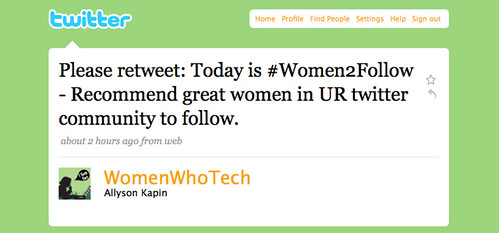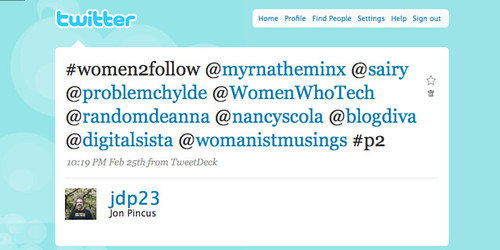
Today, on Twitter, I saw another woman, Allyson Kapin (who goes by @WomenWhoTech), get frustrated when she saw a list of “top” folks in social media that, once again, omitted all but one woman…. Soon after, a discussion ensued, and, within minutes, Kapin started a new “event” on Twitter…
— Denise Graveline on The Eloquent Woman, February 25
The idea behind #Women2Follow Wednesdays is straightforward: to recognize and promote women in the technology and social media field — and help people find each other. If you’re on Twitter, it’s easy to participate.
- Tweet a list of one or more women on Twitter you think people should follow, along with some info about why. Make sure to include the #women2follow hashtag!
- Watch others’ recommendations and find interesting people to follow
Like I said, easy. Here are my recommendations over the last three weeks.
An important point about this approach is that it potentially spreads the benefit around, rather than directing it primarily to the already-powerful. Looking at #women2follow via Twitter search, recommendations from people with a few hundred followers are just as visible as those from people with thousands. And thus far the women being recommended have only a few hundred or few thousand followers, as opposed to the hundreds of thousands for those topping the charts of Twitterholic’s ranking.
This matters a lot from a gender perspective. While women are 53% of the Twitter population, guys outnumber them by almost 3-to-1 on the top 100 rankings. As @maegancarberry points out, Twitter’s dynamics allow a bunch of “ordinary” users (with tens or hundreds of followers) to collaborate in ways that complement the “superusers”. The first few weeks of #women2follow is an excellent example.
Will it stay that way? #followfriday, a longer-running male-dominated version of this approach,* provides a glimpse of a possible future. According to TopFollowFriday’s statistics, there’s a bit of “the rich get richer” going on. @mashable (with 200,000+ followers) tops the list of recommendations. Eight of the top ten already have more than 10,000 followers. On the other hand there are plenty of “real people” in the top 100 as well, and I only spotted a handful of the Twitterholic top 100 on the TopFollowFriday list. So my guess is that #followfriday tends to distribute power rather than concentrating it (although it also strongly reinforces male dominance).
It’ll be interesting to see whether #women2follow has a similar patterns. At least in the US, predominantly-female groups collaborate more effectively than male-dominated groups — and thus farther are only a handful of guys participating in #women2follow. In any case, it’ll clearly empower women.
It’s a fascinating and empowering experiment. Please join in!
jon
PS: Here’s my tweet from a couple of weeks ago, using #p2 (the “progressives 2.0” hashtag) to indicate that these are women who are interested in progressive political issues and value diversity.

jon
* while theoretically #followfriday is gender-neutral, 90% of the top 10 and 75% of the top 30 recomendees are guys — at least according to TopFollowFriday.



Leave a Reply